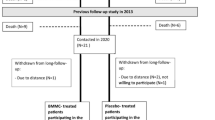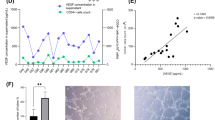Abstract
Initial clinical trials of bone-marrow-derived mononuclear cells after acute myocardial infarction have shown improvement in a number of cardiac indices, including left ventricular systolic function, infarct size, stroke volume, and coronary blood flow. Functional improvements observed in cell therapy studies have been modest, with augmentation of left ventricular function in the range of 6-8%. Nevertheless, these studies have generated considerable debate on a number of issues, including the efficacy of specific cell populations, logistics of cell harvesting and isolation, and, most importantly, the mechanism of cell therapy benefit. With the field on the threshold of large-scale, randomized, controlled clinical trials, additional questions, such as the following, must be asked. Can cell therapy procedures be simplified? Can therapeutic effects be obtained earlier after myocardial infarction? Is cell harvesting a necessary component of cell therapy or can endogenous cells be mobilized sufficiently to obviate the need for processing exogenous cells? In an era when interventional devices are increasingly used in therapeutic approaches to acute myocardial infarction, can current cell therapy practice be integrated with interventional approaches to acute revascularization? Emerging concepts that may address some of these questions include whether paracrine factors released by progenitor or stem cells can be as efficacious as bone-marrow- or blood-derived cells, whether novel progenitor populations mobilized locally in the vessel wall or the heart can participate in repair or regeneration, and whether cell therapy strategies for acute myocardial infarction will evolve to include interventional technologies in combination with paracrine or mobilization factors.
This is a preview of subscription content, access via your institution
Access options
Subscribe to this journal
Receive 12 print issues and online access
$209.00 per year
only $17.42 per issue
Buy this article
- Purchase on Springer Link
- Instant access to full article PDF
Prices may be subject to local taxes which are calculated during checkout
Similar content being viewed by others
References
Assmus B et al. (2002) Transplantation of progenitor cells and regeneration enhancement in acute myocardial infarction (TOPCARE-AMI). Circulation 106: 3009–3017
Strauer BE et al. (2002) Repair of infarcted myocardium by autologous intracoronary mononuclear bone marrow cell transplantation in humans. Circulation 106: 1913–1918
Fernández-Avilés F et al. (2004) Experimental and clinical regenerative capability of human bone marrow cells after myocardial infarction. Circ Res 95: 742–748
Caplice NM et al. (2005) Cell therapy for cardiovascular disease: what cells, what diseases and for whom? Nature Clin Pract Cardiovasc Med 2: 37–43
Wagers AJ and Weissman IL (2004) Plasticity of adult stem cells. Cell 116: 639–648
Rehman J et al. (2003) Peripheral blood “endothelial progenitor cells” are derived from monocyte/macrophages and secrete angiogenic growth factors. Circulation 107: 1164–1169
Rehman J et al. (2004) Secretion of angiogenic and antiapoptotic factors by human adipose stromal cells. Circulation 109: 1292–1298
He T et al. (2005) Paracrine mitogenic effect of human endothelial progenitor cells: role of interleukin-8. Am J Physiol Heart Circ Physiol 289: H968–H972
He T et al. (2004) Human endothelial progenitor cells tolerate oxidative stress due to intrinsically high expression of manganese superoxide dismutase. Arterioscler Thromb Vasc Biol 24: 2021–2027
Gnecchi M et al. (2005) Paracrine action accounts for marked protection of ischemic heart by Akt-modified mesenchymal stem cells. Nat Med 11: 367–368
Urbanek K et al. (2005) Cardiac stem cells possess growth factor receptor systems that after activation regenerate the infarcted myocardium improving ventricular function and long-term survival. Circ Res 97: 663–673
Tang YL et al. (2005) Paracrine action enhances the effects of autologous mesenchymal stem cell transplantation on vascular regeneration in rat model of myocardial infarction. Ann Thor Surg 80: 229–237
Asahara T et al. (1997) Isolation of putative progenitor endothelial cells for angiogenesis. Science 275: 964–967
Ingram DA et al. (2005) Vessel wall-derived endothelial cells rapidly proliferate because they contain a complete hierarchy of endothelial progenitor cells. Blood 105: 2783–2786
Author information
Authors and Affiliations
Corresponding author
Ethics declarations
Competing interests
The author declares no competing financial interests.
Rights and permissions
About this article
Cite this article
Caplice, N. The future of cell therapy for acute myocardial infarction. Nat Rev Cardiol 3 (Suppl 1), S129–S132 (2006). https://doi.org/10.1038/ncpcardio0432
Received:
Accepted:
Issue Date:
DOI: https://doi.org/10.1038/ncpcardio0432
This article is cited by
-
Natural ECM as Biomaterial for Scaffold Based Cardiac Regeneration Using Adult Bone Marrow Derived Stem Cells
Stem Cell Reviews and Reports (2013)
-
An emerging cell-based strategy in orthopaedics: endothelial progenitor cells
Knee Surgery, Sports Traumatology, Arthroscopy (2012)
-
Use of arginine–glycine–aspartic acid adhesion peptides coupled with a new collagen scaffold to engineer a myocardium-like tissue graft
Nature Reviews Cardiology (2009)
-
Therapeutic angiogenesis in cardiovascular disease
Journal of Cardiothoracic Surgery (2007)
-
Clinical trials in stem cell therapy: pitfalls and lessons for the future
Nature Clinical Practice Cardiovascular Medicine (2007)



